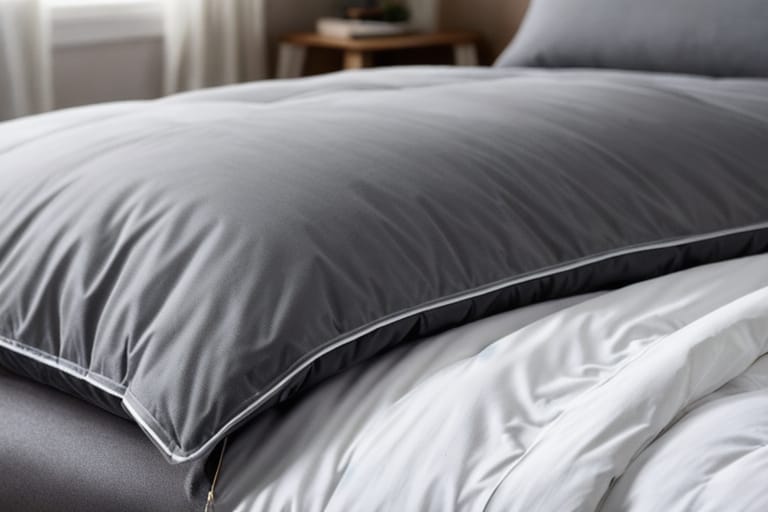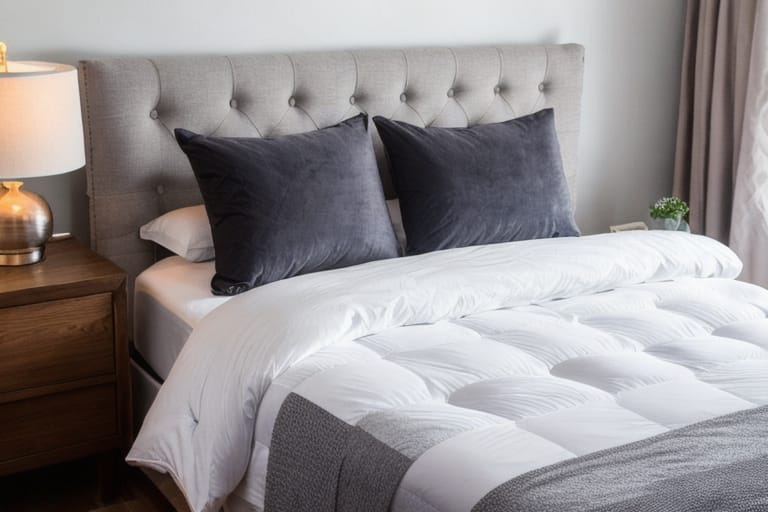Are you looking to add a decadently warm and cozy down comforter to your bedding? With so many options on the market, it can be tricky to determine what makes a quality down comforter that will keep you comfortably warm without overheating or triggering allergies. This beginner’s guide will walk you through everything you need to know when shopping for the best down comforter for your needs and budget.
What Is a Down Comforter?
A down comforter is filled with the fluffy underside plumage from ducks or geese known as down. This natural fill material is highly prized for bedding because it provides unbeatable insulation. The three-dimensional structure of down clusters traps air, acting as a thermal barrier to retain body heat. This makes a down comforter the ultimate in warm and plush bedding.
Down comforters are comprised of several key components:
- Outer shell – Typically made from lightweight fabrics like cotton, cotton sateen, or Egyptian cotton to allow maximum breathability.
- Inner chamber(s) – Separate sewn compartments filled with down.
- Fill power – This measures the loft and quality of the down. Higher fill powers like 800+ last longer and are more insulating.
Benefits of a Down Comforter
There are many benefits that make down comforters a popular bedding choice:
- Lightweight warmth – Down provides the highest warmth-to-weight ratio of any insulation material. Even a light, medium-weight down comforter keeps most sleepers cozy through the night.
- Soft & fluffy – High fill power down with enough fill in the chambers gives down comforters their signature cloud-like plushness.
- Breathability – The fill allows airflow to prevent overheating, making down comforters suitable for all seasons.
- Durability – With proper care, high-quality down comforters can last over 10 years.
- Hypoallergenic options available – For those with allergies, comforters with allergen-blocking fabrics reduce exposure to dust and dander.
Down vs. Down Alternative Comforters
Down alternative comforters offer a cheaper, synthetic alternative to natural goose or duck down:
| Type | Pros | Cons |
|---|---|---|
| Down | Maximum warmth & softness, breathability, durable | Expensive, requires more care, allergy concerns for some |
| Down Alternative | Hypoallergenic, cheaper price, easy care | Less warmth, less soft, less durable over time |
Both down and down alternative comforters come in a wide range of warmth ratings, fill powers, and price points to suit individual sleep needs and budgets.

Factors to Consider When Buying a Down Comforter
Shopping for a down comforter involves assessing a few key factors based on your sleep habits, climate, and budget:
1. Warmth Level
Down comforters keep you pleasantly warm without overheating by trapping body heat. The amount of insulation offered is measured by:
- Fill power – This indicates the loft and quality of down, typically between 600-900+ fill power. Higher numbers mean more insulation.
- Fill weight – Given in ounces or grams per square inch, this shows the density and amount of down inside. Again, more fill = more warmth.
Choose an option suited to the seasons you plan to use it and your natural body temperature as a sleeper:
- Lightweight: For hot sleepers, tropical climates, or summer use
- Midweight: All-season comfort suitable for most people
- Heavyweight: For cold sleepers who want extra coziness for frigid weather
2. Size
Pick a comforter size in sync with your bed size for proper coverage without overhang:
| Bed Size | Comforter Size |
|---|---|
| Twin/Twin XL | 66″ x 86″ |
| Full/Double | 86″ x 86″ |
| Queen | 90″ x 98″ |
| King | 102″ x 98″ |
| California King | 108″ x 102″ |
For extra warmth, size up (i.e. choose a King comforter for a Queen bed).
3. Shell Fabric
Breathable shell fabrics allow airflow to prevent sweating and overheating:
- Cotton – Natural, soft, and breathable but prone to shrinking
- Egyptian or Pima cotton – More durable and longer-lasting
- Sateen cotton – Lightweight with a silky sheen
- Downproof polyester – Budget option less prone to feathers poking through
4. Special Features
Added features to compare include:
- Corner loops – Prevent shifting of the comforter inside a duvet cover
- Baffle box design – Prevents fill from shifting to one side over time
- Allergy resistance – Blocks dust mites and pet dander from entering
5. Budget
Down comforters span a wide range of budgets. Prices depend mainly on:
- Fill power – Higher numbers like 800+ fill are premium quality down
- Fill weight – More expensive since higher density down requires more material
- Shell fabric – Fine fabrics like Egyptian cotton cost more
- Special coatings – Allergen blocking, moisture-wicking fabrics add expense
Expect to spend $150-$300 for a quality mid-range down comforter suitable for year-round use. Sales can knock this down to $100 or less if you don’t need high fill power down. High-end comforters with 800+ fill power down can cost over $500.

Top 6 Down Comforters of 2023
Based on online customer reviews and product testing, here are our picks for the best down comforters to keep you cozy during every season:
| Best Overall | Best Value | Best Lightweight |
|---|---|---|
| Brooklinen Down Comforter 700 fill power. Premium long staple down with cotton sateen shell. | Amazon Basics Lightweight Down Comforter 650 fill power. Great quality for the low price. | Buffy Cloud Comforter Made from recycled materials for eco-friendly shoppers. |
| Most Plush | Best Year-Round | Most Hypoallergenic |
|---|---|---|
| Parachute Down Duvet Insert 750 fill power. Ultra-soft sateen cotton shell. | The Company Store LaCrosse Down Comforter Perfect midweight for all climates. | Beans72 Hypoallergenic Down Comforter Down-proof barrier keeps allergens away. |
No matter your budget or needs, there is a down comforter option to keep you sleeping soundly in cozy warmth all year long. Just be sure to properly care for and clean your comforter to ensure it lasts many years.
Frequently Asked Questions
What is fill power and why does it matter?
Fill power measures the loft and quality of down insulation. It ranges from 600-900+ fill power. The higher the number, the better the insulation and durability. Premium down comforters have 800 to 900+ fill power goose down to provide maximum warmth without heavy weight.
How do I know if a comforter will be warm enough?
To pick the right warmth level, check the fill power first for down quality. Then look at fill weight given in oz/in2 or g/m2. The higher these numbers, the warmer the comforter. A medium weight, 650+ fill power comforter provides all-season coziness for most sleepers.
What’s the benefit of a down alternative comforter?
The main perk of down alternative comforters is that they are hypoallergenic. The synthetic microfiber filling won’t aggravate allergies or asthma. They are also cheaper and easier to care for. The trade-off is less insulation, softness, and longevity versus real goose or duck down.
How often should you replace your down comforter?
With proper care, a quality down comforter lasts over 10 years. Signs it’s time to replace include reduced warmth from clumping or shifting of the down, the shell leaking feathers, worn seams, holes, or stains that won’t come out. Most brands offer free repairs for faults under warranty.
What’s the best way to wash a down comforter at home?
It’s important not to machine wash down at home or the agitation can damage the delicate clusters. Special commercial machines are best. For home care, only dry clean a down comforter once every 2-3 years max to preserve the insulation, loft and prevent premature wear.








